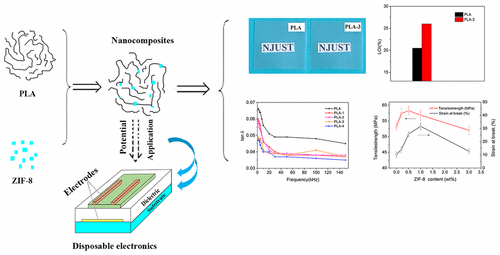Degradable electronic components created from corn starch

As consumers upgrade their gadgets at an increasing pace, the amount of electronic waste we generate continues to mount. To help combat this environmental problem, researchers have modified a degradable bioplastic derived from corn starch or other natural sources for use in more eco-friendly electronic components. They report their development in ACS' journal Industrial & Engineering Chemistry Research.
In 2014, consumers around the world discarded about 42 million metric tons of e-waste, according to a report by the United Nations University. This poses an environmental and human threat because electronic products are made up of many components, some of which are toxic or non-degradable. To help address the issue, Xinlong Wang and colleagues sought to develop a degradable material that could be used for electronic substrates or insulators.
The researchers started with polylactic acid, or PLA, which is a bioplastic that can be derived from corn starch or other natural sources and is already used in the packaging, electronics and automotive industries. PLA by itself, however, is brittle and flammable, and doesn't have the right electrical properties to be a good electronic substrate or insulator. But the researchers found that blending metal-organic framework nanoparticles with PLA resulted in a transparent film with the mechanical, electrical and flame retardant properties that make the material a promising candidate for use in electronics.
The authors acknowledge funding from the Science and Technology Support Program of Jiangsu Province of China and Priority Academic Program Development of Jiangsu Higher Education Institutions.
More information: Xiaowei Shi et al. Degradable Poly(lactic acid)/Metal–Organic Framework Nanocomposites Exhibiting Good Mechanical, Flame Retardant, and Dielectric Properties for the Fabrication of Disposable Electronics, Industrial & Engineering Chemistry Research (2017). DOI: 10.1021/acs.iecr.6b04204
Abstract
Nano metal–organic frameworks (ZIF-8) particles were synthesized, and poly(lactic acid) (PLA)/ZIF-8 nanocomposite films were prepared by solution-blending and film-casting methods. The addition of nano ZIF-8 particles improved the mechanical properties and had an impact on the crystallization of PLA. The electrical properties of the PLA/ZIF-8 nanocomposites were found to be dependent on the frequency and the ZIF-8 content. The prepared PLA/ZIF-8 films had good transparency even as the content of the nano ZIF-8 particles reached 3 wt %. Compared with 21.5% of pure PLA, the limited oxygen index value of the nanocomposite film containing 1 wt % ZIF-8 reached 26.0%. Therefore, it is proposed that the prepared nanocomposites can be used as the substrates and dielectric to make disposable electronics. The char residues after burning were studied in detail by scanning electron microscopy and Raman and X-ray photoelectron spectroscopies, and the flame retardant mechanism was also discussed.
Journal information: Industrial & Engineering Chemistry Research
Provided by American Chemical Society



















